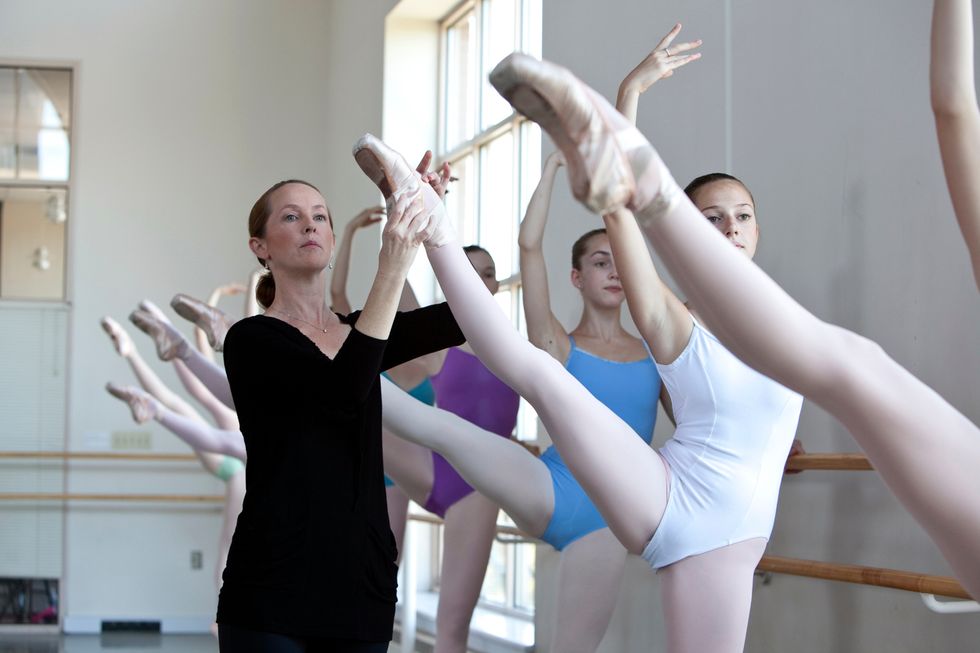
Barre is time for ballet students to develop strength, accurate placement and basic technical skills. But it can seem boring and tedious to young or teen dancers, causing them to zone out and lose interest. Sometimes it just takes a few fresh ideas to perk them up.
Keep students on their toes with small surprises.
Abbie Siegel, school principal at Pacific Northwest Ballet School, changes the musicality or technical structure of a combination to switch things up. “I’ll give something on an odd count, like a five or a three, instead of a four,” she says. “Every once in a while I’ll throw in a jump during a frappé exercise, or a pirouette in a relevé combination.”
Change places.
Margaret Tracey, director of Boston Ballet School, sometimes has students rotate spots after each exercise. “Kids are way too young to get stuck in one place at barre,” she says. “They need to be looking at themselves at different angles every day.” Her younger students, ages 12–14, move one place over after each exercise. Her older students must pick up their bags and relocate to a new spot at the start of class.
Celebrate hard work.
When something finally clicks with a student, you can tell. Maybe she’s balancing longer, or he just realized how to développé with proper hip placement. Recognize these “ah-ha!” moments and celebrate the dancer’s success. “Stay positive, encourage and notice these things,” says Siegel. “When they see how much better they’re getting, it makes them more interested and eager to stick with it.”
Create a legacy.
As a reward system, Tracey names combinations after her students. Maybe a dancer always remembers the correct épaulement or does a step especially well. “It’s one of my ways of connecting with the kids,” she says. “It inspires them to think that one day I’ll name a combination after them.”
Appeal to the competitive spirit.
Using games or competition at barre will help motivate even the youngest students. Challenge them to see who can point their foot the hardest, or who can jump the highest.
Use real-life role models.
At Miami City Ballet School, Maribel Modrono uses professional dancers or athletes to inspire dancers. “I ask them if they could jump as high as LeBron James,” she says. “Or I tell them to pretend that they have on a beautiful tutu that was just made for the principal dancers of Miami City Ballet. Bringing real-life role models into the picture helps them connect.”
 Margaret Tracey asks Boston Ballet School students to come up with their own imagery to describe movement. by Rachel Papo
Margaret Tracey asks Boston Ballet School students to come up with their own imagery to describe movement. by Rachel Papo
Be the music.
Modrono encourages dancers to use their bodies as instruments. “Every now and then they’ll have to snap their fingers on the third count,” she says. “Or clap when their leg opens to the side. After a long day of studying and sitting in a chair, that really wakes them up.”
Change the tempo.
Even if you don’t change the structure of a combination, you can switch accents or adjust the tempo. “Instead of a fondu in a 2/4, I’ll do it in a mazurka or a polonaise,” says Tracey. If students seem bored, she shortens the preparation time to just two counts. “All of a sudden they have to jump in and engage quicker.”
Use creative imagery.
Visuals can inspire students to use their bodies in a different way. “Think of elastic or taffy to lengthen,” says Siegel. “Or do sous-sus like your body is getting sipped up through a straw.” Maybe their toes are hitting hot pavement when they’re doing dégagé with a piqué, or they should have the sensation that their port de bras is moving underwater. “I ask them to come up with their own ways of describing things so they stay engaged,” says Tracey. “Then they’re part of the process.”
Tie it to the rest of class.
Help students understand that the steps they do at barre are the same ones they need in center. “The plié they do in the beginning of class is the same plié they need for grand allégro,” says Tracey. “Show how technique is built on a foundation, and that the foundation starts at barre. It gets them excited to see how everything fits together.”
When Siegel sees that her students are spacing out, she’ll wait until center to address the problem. “I point out that the reason they’re not getting into fifth position after a glissade is because they’re not working hard enough on dégagés at barre, and not getting into fifth,” she says. “That helps motivate them, to see that relationship.”




